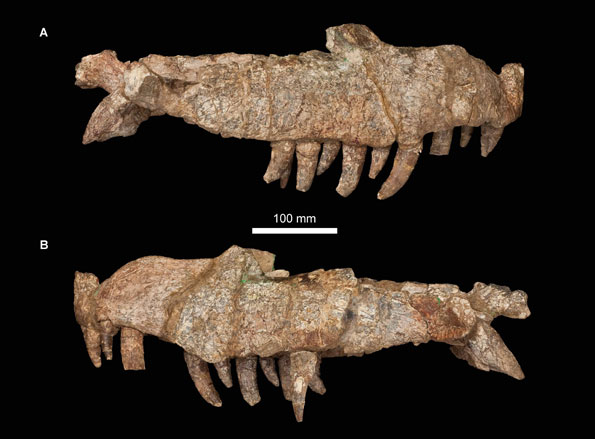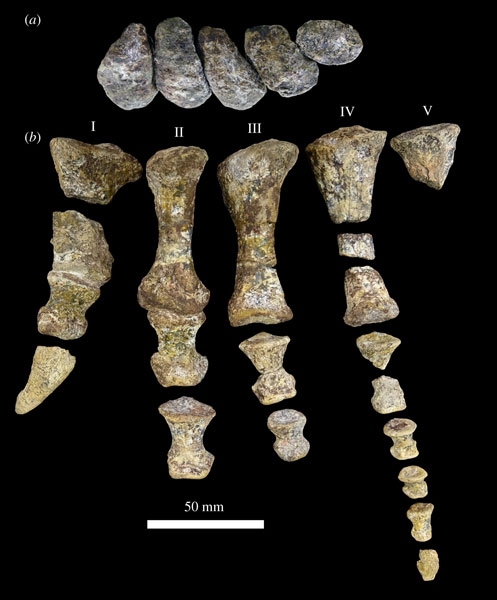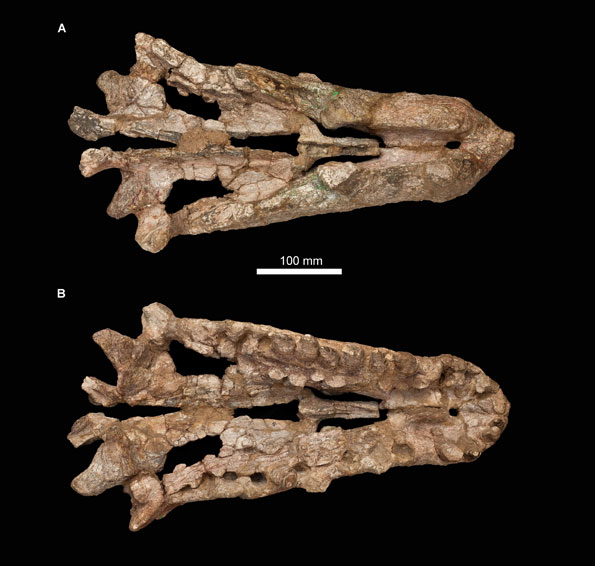Scientists from the University of Birmingham, Virginia Tech (USA) and the London Natural History Museum have described a new super-predator from the Middle Triassic of Tanzania. The ancient archosaur, a very distant relative of modern crocodiles, has been named Mambawakale ruhuhu, with a skull estimated to be around 75 cm long and a total body length of around 5 metres, Mambawakale is one of the largest terrestrial carnivores known from this period in Earth’s history.
Originally referred to as Pallisteria angustimentum, with the genus name honouring geologist John Weaver Pallister OBE (1912–1985), the researchers writing in the open-access journal Royal Society Open Science, wanted to acknowledge the contribution of local scientists and field team members from Tanzania and Zambia. Once it had been established that the fossils represented a new taxon, advice was sought and the genus name Mambawakale (from the regional Kiswahili language meaning “ancient crocodile”) was erected.

Photographs of the skull of Mambawakale ruhuhu (NHMUK R36620) in right lateral view (a) and left lateral view (b). Note scale bar = 100 mm. Picture credit: Butler et al.
Picture credit: Butler et al
The Manda Beds of Tanganyika (Tanzania)
The first, major collection of Triassic fossils from the Middle Triassic Manda Beds exposed in the Ruhuhu Basin of southern Tanzania took place in the 1930s. The research was led by the British geologist Gordon Murray Stockley. At the time Tanganyika was still part of the British Empire and the fossils were removed to the UK, Europe and to South Africa (an independent dominion of the British Empire). The archosaur fossils were studied by Alan Charig in the late 1950s, but this work was not published until after his death in 1997.
In 1963, two years after Tanganyika gained independence and was renamed Tanzania, Alan Charig participated in a British Museum (Natural History Museum) expedition to the region to find more archosaur material. This expedition was heavily reliant on Tanzanians and Zambians who helped excavate fossils, locate dig sites and built roads to permit transport of the fossils. Sadly, the efforts of these people were not recognised in published reports and no Tanzanians or Zambians were named in the publications.
The Mambawakale material consisting of a partial skull, lower jaw, cervical vertebrae and the bones from the left hand (manus), was one of the last sets of fossils from the 1963 expedition to be studied. Once the researchers had identified that these fossils represented a new genus, they wanted to recognise the previously little acknowledged contributions of the Africans, hence, the reference to the Kiswahili language for the genus name. The species epithet makes reference to the Ruhuhu Basin.

Left hand (manus) of the newly described pseudosuchian archosaur Mambawakale ruhuhu (specimen number NHMUK R36620). Picture credit: Butler et al.
Picture credit: Butler et al
One of the Oldest Known Archosaurs
The large skull and heterodont dentition in the anterior portion of the upper jaw, indicate that Mambawakale was a powerful animal and a formidable carnivore.
Corresponding author Richard Butler, Professor of Palaeobiology at the University of Birmingham stated:
“Mambawakale ruhuhu would have been a large and terrifying predator, which roamed across Tanzania some 240 million years ago. At around 5 metres long, it’s one of the largest predators that we know of from this period.”
Analysis of the skull led to the identification of cranial autapomorphies (unique characteristics) that permitted the research team to erect a new genus. The Mambawakale material can be confidently distinguished from all other Manda Bed archosaurs, with the possible exception of the probably very closely related Stagonosuchus nyassicus for which direct comparisons are not possible due to the lack of overlapping fossil bones.

Photographs of the skull of Mambawakale ruhuhu in (a) dorsal view and (b) ventral view. Specimen number NHMUK R36620, note scale bar = 100 mm. Picture credit: Butler et al.
Picture credit: Butler et al
Professor Butler went onto add:
“Our analysis identifies Mambawakale as one of the oldest known archosaurs and an early member of the lineage that eventually evolved into modern crocodilians. It’s an exciting discovery, because identifying this animal helps us to understand the rapid early diversification of archosaurs and enables us to add a further link to the evolutionary story of modern-day crocodiles.”

Life reconstruction of the newly described pseudosuchian Mambawakale ruhuhu. Only the skull, elements from the jaw and fragmentary postcranial material are known so the body shape has been created based on better-known, large pseudosuchian relatives. Picture credit: Gabriel Ugueto.
Picture credit: Gabriel Ugueto
Dating the Manda Beds
Tetrapod fossils associated with the Manda Beds have led palaeontologists to propose that the deposits date from the Anisian stage of the Middle Triassic, however, the age of these rocks remains in dispute. Some recent papers have suggested that the rocks, and therefore the fossils contained therein are actually younger and that the strata were laid down in the Late Triassic (Carnian stage).
Everything Dinosaur acknowledges the assistance of a media release from the University of Birmingham in the compilation of this article.
The scientific paper: “A new pseudosuchian archosaur, Mambawakale ruhuhu gen. et sp. nov., from the Middle Triassic Manda Beds of Tanzania” by Richard J. Butler, Vincent Fernandez, Sterling J. Nesbitt, João Vasco Leite and David J. Gower published in Royal Society Open Science.
The Everything Dinosaur website: Prehistoric Animal Models.






Leave A Comment